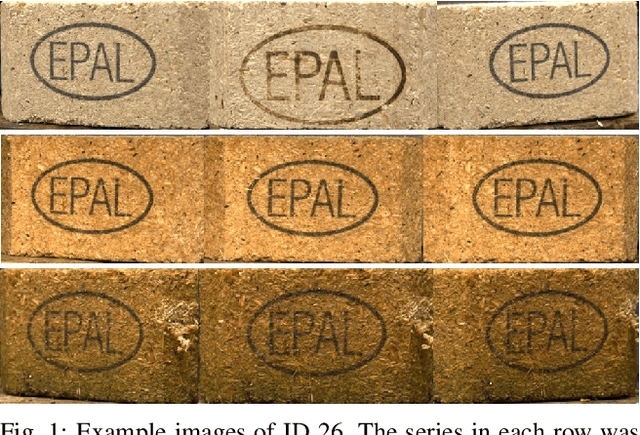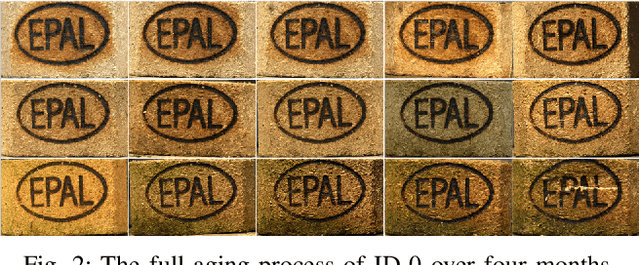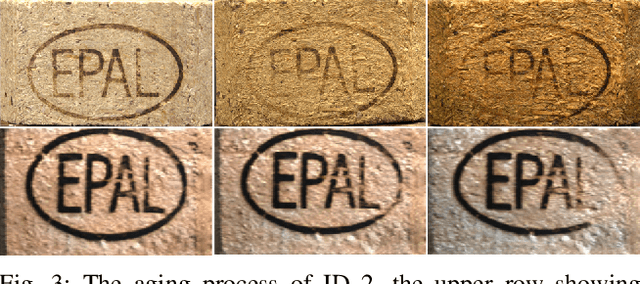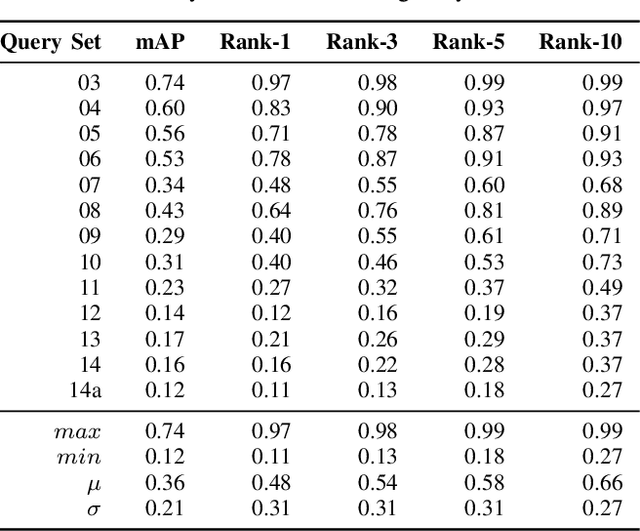Jérôme Rutinowski
MTevent: A Multi-Task Event Camera Dataset for 6D Pose Estimation and Moving Object Detection
May 16, 2025Abstract:Mobile robots are reaching unprecedented speeds, with platforms like Unitree B2, and Fraunhofer O3dyn achieving maximum speeds between 5 and 10 m/s. However, effectively utilizing such speeds remains a challenge due to the limitations of RGB cameras, which suffer from motion blur and fail to provide real-time responsiveness. Event cameras, with their asynchronous operation, and low-latency sensing, offer a promising alternative for high-speed robotic perception. In this work, we introduce MTevent, a dataset designed for 6D pose estimation and moving object detection in highly dynamic environments with large detection distances. Our setup consists of a stereo-event camera and an RGB camera, capturing 75 scenes, each on average 16 seconds, and featuring 16 unique objects under challenging conditions such as extreme viewing angles, varying lighting, and occlusions. MTevent is the first dataset to combine high-speed motion, long-range perception, and real-world object interactions, making it a valuable resource for advancing event-based vision in robotics. To establish a baseline, we evaluate the task of 6D pose estimation using NVIDIA's FoundationPose on RGB images, achieving an Average Recall of 0.22 with ground-truth masks, highlighting the limitations of RGB-based approaches in such dynamic settings. With MTevent, we provide a novel resource to improve perception models and foster further research in high-speed robotic vision. The dataset is available for download https://huggingface.co/datasets/anas-gouda/MTevent
Enhancing Long-Term Re-Identification Robustness Using Synthetic Data: A Comparative Analysis
Apr 25, 2025



Abstract:This contribution explores the impact of synthetic training data usage and the prediction of material wear and aging in the context of re-identification. Different experimental setups and gallery set expanding strategies are tested, analyzing their impact on performance over time for aging re-identification subjects. Using a continuously updating gallery, we were able to increase our mean Rank-1 accuracy by 24%, as material aging was taken into account step by step. In addition, using models trained with 10% artificial training data, Rank-1 accuracy could be increased by up to 13%, in comparison to a model trained on only real-world data, significantly boosting generalized performance on hold-out data. Finally, this work introduces a novel, open-source re-identification dataset, pallet-block-2696. This dataset contains 2,696 images of Euro pallets, taken over a period of 4 months. During this time, natural aging processes occurred and some of the pallets were damaged during their usage. These wear and tear processes significantly changed the appearance of the pallets, providing a dataset that can be used to generate synthetically aged pallets or other wooden materials.
* Published in: 2024 International Conference on Machine Learning and Applications (ICMLA), IEEE. 6 pages, 3 figures
A Cautionary Tale About "Neutrally" Informative AI Tools Ahead of the 2025 Federal Elections in Germany
Feb 21, 2025Abstract:In this study, we examine the reliability of AI-based Voting Advice Applications (VAAs) and large language models (LLMs) in providing objective political information. Our analysis is based upon a comparison with party responses to 38 statements of the Wahl-O-Mat, a well-established German online tool that helps inform voters by comparing their views with political party positions. For the LLMs, we identify significant biases. They exhibit a strong alignment (over 75% on average) with left-wing parties and a substantially lower alignment with center-right (smaller 50%) and right-wing parties (around 30%). Furthermore, for the VAAs, intended to objectively inform voters, we found substantial deviations from the parties' stated positions in Wahl-O-Mat: While one VAA deviated in 25% of cases, another VAA showed deviations in more than 50% of cases. For the latter, we even observed that simple prompt injections led to severe hallucinations, including false claims such as non-existent connections between political parties and right-wing extremist ties.
Is GPT-4 Less Politically Biased than GPT-3.5? A Renewed Investigation of ChatGPT's Political Biases
Oct 28, 2024



Abstract:This work investigates the political biases and personality traits of ChatGPT, specifically comparing GPT-3.5 to GPT-4. In addition, the ability of the models to emulate political viewpoints (e.g., liberal or conservative positions) is analyzed. The Political Compass Test and the Big Five Personality Test were employed 100 times for each scenario, providing statistically significant results and an insight into the results correlations. The responses were analyzed by computing averages, standard deviations, and performing significance tests to investigate differences between GPT-3.5 and GPT-4. Correlations were found for traits that have been shown to be interdependent in human studies. Both models showed a progressive and libertarian political bias, with GPT-4's biases being slightly, but negligibly, less pronounced. Specifically, on the Political Compass, GPT-3.5 scored -6.59 on the economic axis and -6.07 on the social axis, whereas GPT-4 scored -5.40 and -4.73. In contrast to GPT-3.5, GPT-4 showed a remarkable capacity to emulate assigned political viewpoints, accurately reflecting the assigned quadrant (libertarian-left, libertarian-right, authoritarian-left, authoritarian-right) in all four tested instances. On the Big Five Personality Test, GPT-3.5 showed highly pronounced Openness and Agreeableness traits (O: 85.9%, A: 84.6%). Such pronounced traits correlate with libertarian views in human studies. While GPT-4 overall exhibited less pronounced Big Five personality traits, it did show a notably higher Neuroticism score. Assigned political orientations influenced Openness, Agreeableness, and Conscientiousness, again reflecting interdependencies observed in human studies. Finally, we observed that test sequencing affected ChatGPT's responses and the observed correlations, indicating a form of contextual memory.
On the Effectiveness of Heterogeneous Ensemble Methods for Re-identification
Mar 19, 2024



Abstract:In this contribution, we introduce a novel ensemble method for the re-identification of industrial entities, using images of chipwood pallets and galvanized metal plates as dataset examples. Our algorithms replace commonly used, complex siamese neural networks with an ensemble of simplified, rudimentary models, providing wider applicability, especially in hardware-restricted scenarios. Each ensemble sub-model uses different types of extracted features of the given data as its input, allowing for the creation of effective ensembles in a fraction of the training duration needed for more complex state-of-the-art models. We reach state-of-the-art performance at our task, with a Rank-1 accuracy of over 77% and a Rank-10 accuracy of over 99%, and introduce five distinct feature extraction approaches, and study their combination using different ensemble methods.
Behind the Screen: Investigating ChatGPT's Dark Personality Traits and Conspiracy Beliefs
Feb 06, 2024Abstract:ChatGPT is notorious for its intransparent behavior. This paper tries to shed light on this, providing an in-depth analysis of the dark personality traits and conspiracy beliefs of GPT-3.5 and GPT-4. Different psychological tests and questionnaires were employed, including the Dark Factor Test, the Mach-IV Scale, the Generic Conspiracy Belief Scale, and the Conspiracy Mentality Scale. The responses were analyzed computing average scores, standard deviations, and significance tests to investigate differences between GPT-3.5 and GPT-4. For traits that have shown to be interdependent in human studies, correlations were considered. Additionally, system roles corresponding to groups that have shown distinct answering behavior in the corresponding questionnaires were applied to examine the models' ability to reflect characteristics associated with these roles in their responses. Dark personality traits and conspiracy beliefs were not particularly pronounced in either model with little differences between GPT-3.5 and GPT-4. However, GPT-4 showed a pronounced tendency to believe in information withholding. This is particularly intriguing given that GPT-4 is trained on a significantly larger dataset than GPT-3.5. Apparently, in this case an increased data exposure correlates with a greater belief in the control of information. An assignment of extreme political affiliations increased the belief in conspiracy theories. Test sequencing affected the models' responses and the observed correlations, indicating a form of contextual memory.
Object Pose Estimation Annotation Pipeline for Multi-view Monocular Camera Systems in Industrial Settings
Oct 23, 2023Abstract:Object localization, and more specifically object pose estimation, in large industrial spaces such as warehouses and production facilities, is essential for material flow operations. Traditional approaches rely on artificial artifacts installed in the environment or excessively expensive equipment, that is not suitable at scale. A more practical approach is to utilize existing cameras in such spaces in order to address the underlying pose estimation problem and to localize objects of interest. In order to leverage state-of-the-art methods in deep learning for object pose estimation, large amounts of data need to be collected and annotated. In this work, we provide an approach to the annotation of large datasets of monocular images without the need for manual labor. Our approach localizes cameras in space, unifies their location with a motion capture system, and uses a set of linear mappings to project 3D models of objects of interest at their ground truth 6D pose locations. We test our pipeline on a custom dataset collected from a system of eight cameras in an industrial setting that mimics the intended area of operation. Our approach was able to provide consistent quality annotations for our dataset with 26, 482 object instances at a fraction of the time required by human annotators.
The Self-Perception and Political Biases of ChatGPT
Apr 14, 2023Abstract:This contribution analyzes the self-perception and political biases of OpenAI's Large Language Model ChatGPT. Taking into account the first small-scale reports and studies that have emerged, claiming that ChatGPT is politically biased towards progressive and libertarian points of view, this contribution aims to provide further clarity on this subject. For this purpose, ChatGPT was asked to answer the questions posed by the political compass test as well as similar questionnaires that are specific to the respective politics of the G7 member states. These eight tests were repeated ten times each and revealed that ChatGPT seems to hold a bias towards progressive views. The political compass test revealed a bias towards progressive and libertarian views, with the average coordinates on the political compass being (-6.48, -5.99) (with (0, 0) the center of the compass, i.e., centrism and the axes ranging from -10 to 10), supporting the claims of prior research. The political questionnaires for the G7 member states indicated a bias towards progressive views but no significant bias between authoritarian and libertarian views, contradicting the findings of prior reports, with the average coordinates being (-3.27, 0.58). In addition, ChatGPT's Big Five personality traits were tested using the OCEAN test and its personality type was queried using the Myers-Briggs Type Indicator (MBTI) test. Finally, the maliciousness of ChatGPT was evaluated using the Dark Factor test. These three tests were also repeated ten times each, revealing that ChatGPT perceives itself as highly open and agreeable, has the Myers-Briggs personality type ENFJ, and is among the 15% of test-takers with the least pronounced dark traits.
Semi-Automated Computer Vision based Tracking of Multiple Industrial Entities -- A Framework and Dataset Creation Approach
Apr 03, 2023Abstract:This contribution presents the TOMIE framework (Tracking Of Multiple Industrial Entities), a framework for the continuous tracking of industrial entities (e.g., pallets, crates, barrels) over a network of, in this example, six RGB cameras. This framework, makes use of multiple sensors, data pipelines and data annotation procedures, and is described in detail in this contribution. With the vision of a fully automated tracking system for industrial entities in mind, it enables researchers to efficiently capture high quality data in an industrial setting. Using this framework, an image dataset, the TOMIE dataset, is created, which at the same time is used to gauge the framework's validity. This dataset contains annotation files for 112,860 frames and 640,936 entity instances that are captured from a set of six cameras that perceive a large indoor space. This dataset out-scales comparable datasets by a factor of four and is made up of scenarios, drawn from industrial applications from the sector of warehousing. Three tracking algorithms, namely ByteTrack, Bot-Sort and SiamMOT are applied to this dataset, serving as a proof-of-concept and providing tracking results that are comparable to the state of the art.
On the Applicability of Synthetic Data for Re-Identification
Dec 20, 2022



Abstract:This contribution demonstrates the feasibility of applying Generative Adversarial Networks (GANs) on images of EPAL pallet blocks for dataset enhancement in the context of re-identification. For many industrial applications of re-identification methods, datasets of sufficient volume would otherwise be unattainable in non-laboratory settings. Using a state-of-the-art GAN architecture, namely CycleGAN, images of pallet blocks rotated to their left-hand side were generated from images of visually centered pallet blocks, based on images of rotated pallet blocks that were recorded as part of a previously recorded and published dataset. In this process, the unique chipwood pattern of the pallet block surface structure was retained, only changing the orientation of the pallet block itself. By doing so, synthetic data for re-identification testing and training purposes was generated, in a manner that is distinct from ordinary data augmentation. In total, 1,004 new images of pallet blocks were generated. The quality of the generated images was gauged using a perspective classifier that was trained on the original images and then applied to the synthetic ones, comparing the accuracy between the two sets of images. The classification accuracy was 98% for the original images and 92% for the synthetic images. In addition, the generated images were also used in a re-identification task, in order to re-identify original images based on synthetic ones. The accuracy in this scenario was up to 88% for synthetic images, compared to 96% for original images. Through this evaluation, it is established, whether or not a generated pallet block image closely resembles its original counterpart.
 Add to Chrome
Add to Chrome Add to Firefox
Add to Firefox Add to Edge
Add to Edge